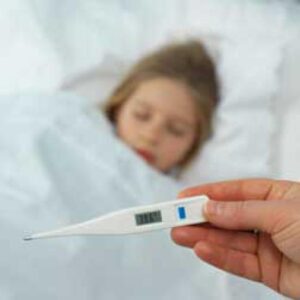
Many thanks to today’s blogger…
Alison Griffin, Nurse Practitioner (ARNP) Weiss Pediatric Care
We’ve probably all been there at some point (or we will in the future!). Our child wakes up crying in the night. You go in and put a hand on her head to find her “burning up” with red tear stained cheeks. In a groggy instant you ask yourself…
Where’s my thermometer!?
How high is “too high” for a fever?
Should I call the doctor or go to the ER?
What’s causing the fever????
What now?
Take a deep breath! 😊 Here are a few FEVER FACTS that can help us stay calm and help our kiddos to weather the storm. FACT: Fevers can be caused by common viruses or bacteria and can last 3-4 days while the body fights off the germs. Fevers aren’t the bad guys. They’re the superheroes who kill the germs that can’t survive in higher body temperatures. When we’re being logical, we might even raise a cheer for fever. “Hooray, my child’s immune system is working to fight off an infection!” And still, we often want to know the exact number on the thermometer that should be cause for worry. FACT: The number on the thermometer is not what’s important; it’s how the child is looking and acting. Children often feel tired and cranky with a fever and won’t want to play or eat as much as much as usual. What’s more important than the number on the thermometer is whether the child is able to arouse, sit up and drink some water. FACT: Did you know that the brain and body work together to help fevers caused by infections to typically stay at 104 degrees or lower? Occasionally, fevers can rise to 105 or 106 degrees, which although on the high side, still aren’t dangerous and won’t cause brain damage. In very, very rare cases, a fever might trigger a seizure. Thankfully, seizures caused by fever won’t harm the child (even though they will likely scare us!). While we know that most of the time fevers aren’t worrisome, what can we do in the middle of the night or anytime when our kids have a fever?- Kids only need to be treated with fever meds IF they are uncomfortable, which is usually above 102-103 degrees.
- If you choose to treat for comfort with fever medications such as Tylenol (acetaminophen) or Motrin (ibuprofen), be sure to stick with just one. Alternating the two, or mixing medicines, can lead to dangerous confusion and over medicating.
